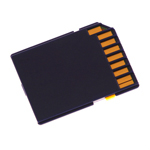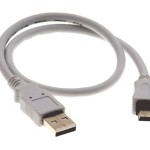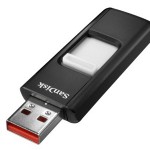In the early days of digital photography, when both computers and memory cards lacked sufficient storage space, photos had to be stored separately.
Now, though, computers, memory cards, external hard drives and various types of free software offer ample storage capacity and the convenience of keeping photos all in one place. Below are a few options.
Memory cards
All digital cameras store the photos you take on a memory card (right), which is inserted usually via a small door on the side or underside of the camera. Memory cards these days can store in excess of 100GB (1 gigabyte [GB] = 1,000 megabytes [MB]) worth of pictures. The average card stores 16–32GB, can be bought anywhere and is relatively inexpensive.
Most popular cameras use ‘SD cards’ (SD = secure digital), while more professional ones have different format cards. If you’re a casual photographer, you’ll probably find that your camera’s memory card offers sufficient space for storing all your photos.
External hard drive

Like memory cards, external hard drives have come down in price a great deal over the past few years. You can buy external hard drives with a 160GB capacity for as little as £30. They connect to your computer via a USB cable (left). You can drag and drop photos from your image folder on your computer on to the external hard drive.
Because they’re small and lightweight, you can then give the drive to friends or family who want copies of your photos. An external drive is also a great way to keep your photos secure, especially if you keep it somewhere hidden away from your computer.
USB sticks

You’ve probably seen a USB stick (right) even if you don’t have one. They look like little key chains, and people often do keep them on their key ring. You can buy one for about a tenner, and nowadays they’ll store around 10GB worth of files.
Simply remove the cap, insert the end into the USB slot on your computer, then drag and drop the photos you want to store on the stick on to its icon, which will have appeared on your desktop. Then drag the icon to the rubbish bin and remove the USB stick from the computer. It takes seconds. These are a great, inexpensive way of storing a select group of photos and taking them with you.
Your computer
Keeping your photos on your computer’s internal hard drive is another option for picture storage.
This way of storing your pictures is easy and makes them readily accessible. However, it’s highly advisable to keep a back-up folder of your pictures in the event that your computer breaks down or is stolen. Again, this is where external hard drives prove their worth.
Online storage
If you don’t want to spring for an external hard drive and your computer is already quite full, there are a number of free services online that will let you store photos for free. The most popular are the photo-sharing websites Flickr, Photobucket, Shutterfly and the like. You can also keep photos on Facebook.
All of these websites offer a certain amount of free photo storage, but some may limit how many you can upload per month before you have to pay. However, if you’re a casual photographer, you probably won’t exceed the monthly upload limit of the free account. What’s more, your pictures will be visible to you and others on these photo-sharing sites. For more information, see our guides How to share photos and How to upload photos on Facebook.
If you want to store more pictures online and aren’t looking for feedback, just a safe place to back up your computer’s hard drive, an online file storage site is probably what you need. Websites like DropBox, and Google drive.
Microsoft even has its own online file storage One Drive.
Last updated February 2023